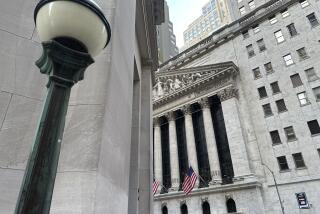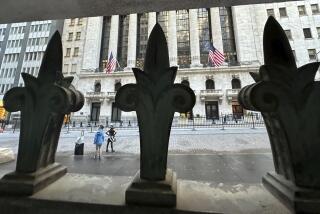Long-Term Bond Yields Continue Slide
- Share via
Long-term Treasury bond yields fell by midday Monday to the lowest levels in about four decades, continuing to defy expectations that a bottom has been reached in this year’s rate slide.
But the ongoing decline is posing a quandary for bond fund managers: If they continue to buy Treasuries at these yields, they risk severe whiplash if market interest rates resurge.
The yield on the benchmark 10-year T-note sank by midday Monday to as low as 3.87% before rebounding to close at 3.91%, matching Friday’s level.
The yield on the 30-year T-bond hit a new closing low at 4.76%, down from 4.77% on Friday.
Investors who balked at buying long-term Treasuries in midsummer because of low yields now may wish they had jumped in: The 10-year T-note was 4.46% at the end of July, more than half a point higher than today.
“I’ve been doing this since 1979, and, like a lot of people, I’ve got sticker shock right now,” said Richard Schlanger, portfolio manager at Pioneer Investments in Boston.
The plunge in yields has made older fixed-rate Treasury bonds more valuable, pushing their prices higher. That has driven the “total return” on some government-bond mutual funds into double digits year to date. Total return counts interest earnings plus any change in principal value.
Some bond market pros say they don’t think rates can fall much further, barring a new recession. And if the economy rebounds, experts concede that the next turn for rates probably will be up, driving bond principal values lower.
But that isn’t stopping investors from continuing to shovel cash into bond funds.
Charles Biderman, president of TrimTabs.com Investment Research in Santa Rosa, Calif., estimates that a net $15 billion poured into bond funds in August, with inflows continuing at that pace or better in September.
Stock funds, meanwhile, might be on their way to a fourth straight month of net outflows, according to TrimTabs.
“Flows follow performance and [bonds are] really the only asset class that’s making any money,” Biderman said.
“Typically, this is what happens at the top,” he warned, noting that stock fund inflows reached a crescendo in spring 2000, just before the 2 1/2-year downturn for stocks.
Biderman said the bond rally could continue for several months, but investors banking on such stellar Treasury returns forever will inevitably be disappointed, he said.
“It’s the rearview mirror style of investing: You have your foot on the gas, your hands on the wheel and your eyes on the rearview mirror.... At some point you crash,” he said.
Still, Schlanger said individual investors continue to reallocate assets into fixed income in part because they feel “burned” by equities.
“A lot of people who have seen their 401(k)s cut dramatically want to preserve what they have left,” he said.
Meanwhile, retirees who rely on income-producing investments and who want to raise that income have little choice but to buy longer-term bonds, with returns on money market funds at record lows of about 1.3%, experts say.
Though recent bond fund cash inflows may look like “hot money,” Treasury fund managers say fundamental factors continue to underpin the rally in long-term bonds.
“We’ve been surprised by the magnitude of this rally, but if you peel back the layers of the onion, this thing could have further longevity,” Schlanger said. He said 10-year rates could fall to 3.5% over the next two quarters.
Among other factors, Schlanger said the “yield curve,” or the gap between long-and short-term rates, remains steep by historical standards; 30-year Treasury debt is no longer being issued; and mortgage giant Fannie Mae may have to buy 10-year T-notes to bolster its assets because the home-refinancing wave has chipped away at its mortgage portfolio.
Also, a war with Iraq could spur a new “flight to quality” that benefits Treasuries, Schlanger said.
Others say the continuing Treasury rally could be a signal that investors expect either a return to recession or another cut in short-term interest rates by the Federal Reserve aimed at staving off a so-called double dip.
Ashok Bhatia, portfolio manager at Strong Funds in Menomonee Falls, Wis., said although the “fundamental themes” for a solid Treasury market are still in place, the plunge in yields since June could be setting the stage for a correction that sends rates temporarily higher.
“In the short term you have to be cautious,” he said. “But do we have a ‘bond bubble’? I don’t think so.”
Fund managers and investors can take steps to minimize the risk of rate whiplash, experts say.
Bhatia is keeping his portfolios very close to their benchmark average “duration”--a measure of bond maturity--of four years, he said. By contrast, earlier in the year the average had crept up to 4.25 years as he anticipated a decline in rates. A shorter duration could limit a fund’s principal losses if market rates rise.
Bhatia also is buying more mortgage and U.S. agency securities that could perform relatively well even if rates rise, he said.
Don Cassidy, analyst at fund tracker Lipper Inc. in Denver, said investors fearful of rate whiplash might want to consider funds that own so-called TIPS, or Treasury inflation-protected securities. TIPS are an insurance policy against inflation, offering guaranteed returns above the consumer price index.
As for most long-term bond funds, however, Cassidy said portfolio managers don’t have much leeway to protect against rebounding rates. “If you’re a long-term fund, you’re a long-term fund.”
More to Read
Inside the business of entertainment
The Wide Shot brings you news, analysis and insights on everything from streaming wars to production — and what it all means for the future.
You may occasionally receive promotional content from the Los Angeles Times.










